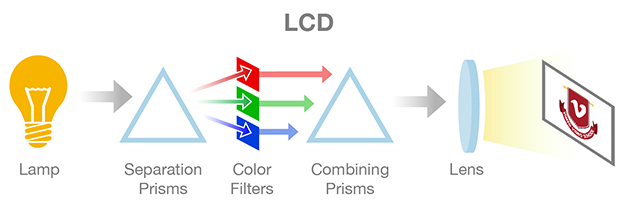A projector is an optical device that projects an image onto a surface, commonly a projection screen. A beam of high-intensity light travels through thousands of shifting pixels in an LCD display instead of through a frame of translucent film.

It all begins with a powerful light source emits a beam of intense, white light. This beam of white light bounces off a group of mirrors that includes two dichroic mirrors. These mirrors are coated in a special film that reflects only a specified wavelength of light. Each dichroic mirror breaks off a single specified wavelength, so the white light hits the mirrors, and each reflects a beam of colored light on through the projector: one red, one green and one blue. The beams of red, green and blue light each pass through a liquid crystal display composed of thousands of tiny, colorless pixels that either block light or allow it to pass through when triggered by an electric current. The LCD screens in the projector display the same image or moving images, only in gray scale. When the colored light passes through these three screens, they relay three versions of the same scene: one tinted red, one tinted green and one tinted blue. The final image we see isn’t red, green or blue; it’s full color, so inside the LCD projector, the three tinted versions of this scene recombine in a dichroic prism to form a single image composed of millions of colors. The light of this vibrant, colorful version of the scene then passes through a projector lens and onto the big screen.
